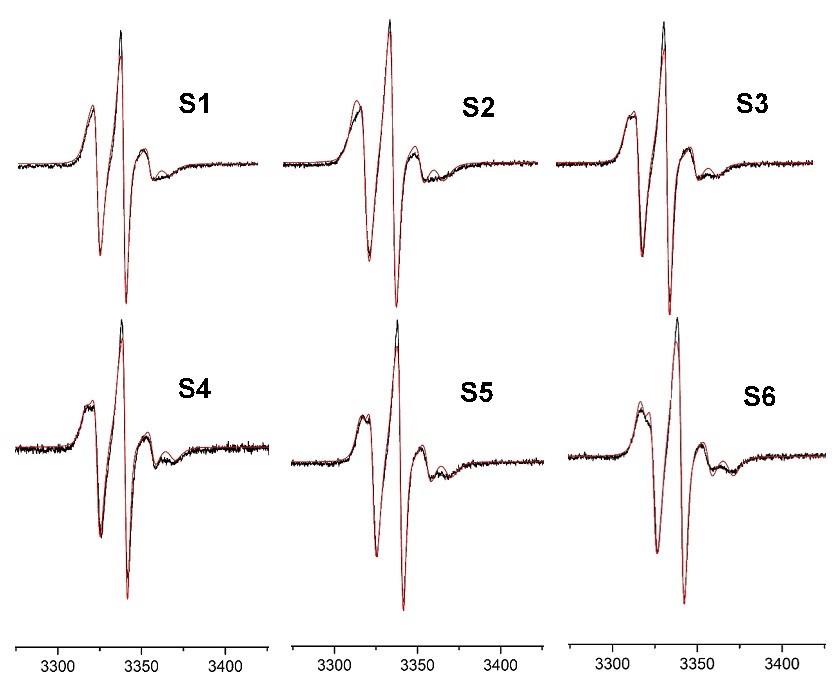
Combination of fluorescent and spin labels: a powerful method for the optimization of hydrophilic membranes for the separation of oil-in-water emulsions
Abstract
Keywords
Full Text:
PDFReferences
Kuimov VM, Kryazhov AN, Yagupov AI, Elagin AA, Mironov MA. Biopolymer-based membranes: green technologies for the separation of oil–water mixtures and the reduction of oil pollution. Clean Techn Environ Policy. 2022;24:1961–1985. doi:10.1007/s10098-022-02306-0
Zhu Y, Wang D, Jiang L, Jin J. Recent progress in developing advanced membranes for emulsified oil/water separation. NPG Asia Mater. 2014;6:101–111. doi:10.1038/am.2014.23
Wang H, Hu X, Ke Z. Review: porous metal filters and membranes for oil-water separation. Nanoscale Res Lett. 2018;13:1–14. doi:10.1186/s11671-018-2693-0
Zirehpour A, Rahimpour A. Membranes for wastewater treatment. In: Nanostructured polymer membranes. vol 2. London: Wiley; 2016. pp 159–207. doi:10.1002/9781118831823.ch4
Shahruddin MZ, Othman NH, Alias NH, Ghani SNA. Desalination of produced water using bentonite as pretreatment and membrane separation as main treatment. Procedia. 2015;195:2094–2100. doi:10.1016/j.sbspro.2015.06.237
Zulfiqar U, Thomas AG, Matthews A, Lewis DJ. Surface engineering of ceramic nanomaterials for separation of oil/water mixtures. Front Chem. 2020;8:587. doi:10.3389/fchem.2020.00578
Yuan J, Cui C, Qi B. Experimental investigation of copper mesh substrate with selective wettability to separate oil/water mixture. Energies. 2019;12:1–19. doi:10.3390/en122 34564
Lin X, Hong J. Recent advances in robust superwettable membranes for oil-water separation. Adv Mater Interfaces. 2019;6:1–23. doi:10.1002/admi.201900126
Wang Y, Su Y, Wang W. The advances of polysaccharide-based aerogels: preparation and potential application. Carbohydr Polym. 2019;226:115242. doi:10.1016/j.carbpol.2019.115242
Cheng QY, Guan CS, Li YD. Robust and durable superhydrophobic cotton fabrics via a one-step solvothermal method for efficient oil/water separation. Cellulose. 2019;26:2861–2872. doi:10.1007/s10570-019-02267-6
Sun S, Xiao QR, Zhou X. A bio-based environment-friendly membrane with facile preparation process for oil-water separation. Colloids Surfaces A. 2018;559:18–22. doi:10.1016/j.colsurfa.2018.09.038
Zeng M, Echols I, Wang P. Highly biocompatible, underwater superhydrophilic and multifunctional biopolymer membrane for efficient oil-water separation and aqueous pollutant removal. ACS Sustain Chem Eng. 2018;6:3879–3887. doi:10.1021/acssuschemeng.7b04219
Wang Z, Ji S, Zhang J. Tannic acid encountering ovalbumin: a green and mild strategy for superhydrophilic and underwater superoleophobic modification of various hydrophobic membranes for oil/water separation. J Mater Chem A. 2018;6:13959–13967. doi:10.1039/c8ta03794a
Wang M, Peng M, Zhu J, Li YD, Zeng JB. Mussel-inspired chitosan modified superhydrophilic and underwater super-oleophobic cotton fabric for efficient oil/water separation. Carbohydr Polym. 2020;244:116449. doi:10.1016/j.carbpol.2020.116449
Liu Q, Patel AA, Liu L. Superhydrophilic and underwater superoleophobic poly (sulfobetaine methacrylate)-grafted glass fiber filters for oil–water separation. ACS Appl Mater Interfaces. 2014;6(12):8996–9003. doi:10.1021/am502302g
Gomes BR, Araújo R, Sousa T, Figueira RB. Sol-gel coating membranes for optical fiber sensors for concrete structures monitoring. Coatings. 2021;11(10):1245. doi:10.3390/coatings11101245
Spettmann D, Eppmann S, Flemming HC, Wingender J. Simultaneous visualisation of biofouling, organic and inorganic particle fouling on separation membranes. Water Sci Technol. 2007;55(8–9):207–210. doi:10.2166/wst.2007.260
Yuan B, Wang X, Tang C, Li X, Yu G. In situ observation of the growth of biofouling layer in osmotic membrane bioreactors by multiple fluorescence labeling and confocal laser scanning microscopy. Water Res. 2015;75:188–200. doi:10.1016/j.watres.2015.02.048
Rabe M, Verdes D, Seeger S. Understanding protein adsorption phenomena at solid surfaces. Adv Colloid Interface Sci. 2011;162:87–106. doi:10.1016/j.cis.2010.12.007
Barnes JP, Liang Z, Mchaourab HS, Freed JH, Hubbell WL. A multifrequency electron spin resonance study of T4 lysozyme dynamics. Biophys J. 1999;76:3298–3306. doi:10.1016/S0006-3495(99)77482-5
Sahu ID, Lorigan GA. Site-Directed Spin Labeling EPR for Studying Membrane Proteins. BioMed Res Int. 2018:2018. doi:10.1155/2018/3248289
Fournier C, Leonard M, Dellacherie E, Chikhi M, Hommel H, Legrand AP. EPR spectroscopy analysis of hydrophobically modified dextran-coated polystyrene. J Colloid Interface Sci. 1998;198(1):27–33. doi:10.1006/jcis.1997.5234
Touhami A, Hommel H, Legrand AP, Serres A, Muller D, Jozefonvicz J. Spin-labelling study of dextran-coated silica: effect of functionalisation. Colloids Surfaces B: Biointerfaces. 1993;1(3):189–195. doi:10.1016/0927-7765(93)80050-9
Lawrence J. Spin Labeling Theory and Applications. New York: Academic Press; 1976. 465 p.
Vorobiev AK, Bogdanov AV, Yankova TS, Chumakova NA. Spin probe determination of molecular orientation distribution and rotational mobility in liquid crystals: model-free approach. J Phys Chem B. 2019;123:5875–5891. doi:10.1021/acs.jpcb.9b05431
Krinichnyi VI. 2-Mm Wave Band EPR Spectroscopy of Condensed Systems. Florida: CRC Press; 2018. 274 p. doi:10.1201/9781351069373
Artyukh RI, Kachalova GS, Samaryanov BA, Timofeev VP. Dynamic mobility of the histidine-containing domain in spin-labeled lysozyme. Mol Biol. 1995;29(1):87–92.
Antonov DO, Chumakova NA, Kovaleva EG. Orientation of spin-labeled lysozyme from chicken egg white immobilized on porous oxide carriers. Appl Mag Resonance. 2020;51:679–690. doi:10.1007/s00723-020-01231-z
Elagin AA, Mironov MA, Ponomarev VS, authors; Npo Biomikrogel, assignee. Polysaccharide microgels or cleaning water of petroleum and petroleum products and method for using same (variants). European patent EP2862843 A1. 2015 Apr 22.
Elagin AA, Mironov MA, Shulepov ID, authors; Biomicrogels UK, assignee. Substance for collecting petroleum or petroleum products from surface of water and utilization method thereof. European patent EP3156470 A1. 2017 Apr 19.
DOI: https://doi.org/10.15826/chimtech.2023.10.4.15
Copyright (c) 2023 Rita S. Alqubelat, Alena D. Kuznetsova, Denis O. Antonov, Maxim A. Mironov

This work is licensed under a Creative Commons Attribution 4.0 International License.
Chimica Techno Acta, 2014–2025
eISSN 2411-1414
Copyright Notice







